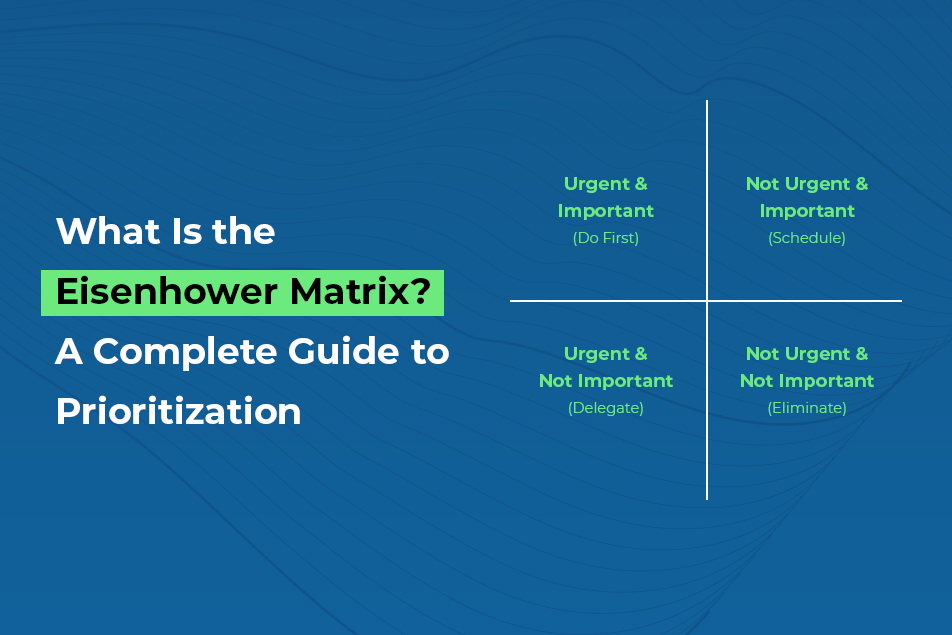In today’s fast-paced world, time often feels like it slips through our fingers. With never-ending to-do lists, deadlines, and distractions, managing time effectively has become a critical skill for success. That’s where the Time Management Matrix comes in—a simple yet powerful tool designed to help you prioritize your tasks, make better decisions, and boost productivity.
The Time Management Matrix helps you take control of your schedule by organizing your tasks based on urgency and importance. By clearly identifying what needs your immediate attention and what can be planned or even eliminated, this matrix allows you to focus on what truly matters—without getting overwhelmed.
Whether you’re a student, a working professional, or someone striving for better work-life balance, the Time Management Matrix can guide your daily actions and long-term planning. It’s not just about doing more; it’s about doing what matters most.
What Is the Time Management Matrix?
The Time Management Matrix is a powerful tool that helps you organize your daily tasks by separating them based on urgency and importance. It allows you to see clearly where your time should go, what needs your immediate attention, and what tasks may be better handled later—or not at all.
The idea of the Time Management Matrix was originally inspired by former U.S. President Dwight D. Eisenhower, who was known for his remarkable productivity and decision-making skills. He often used a simple strategy to distinguish between urgent tasks and important ones. This concept was later popularized by author Stephen R. Covey in his best-selling book The 7 Habits of Highly Effective People. Covey adapted it into a visual four-quadrant matrix that became widely used for personal and professional time management.
The main purpose of the Time Management Matrix is to help you focus on what truly matters. By sorting your tasks into categories, you gain clarity and direction. Instead of reacting to every task that comes your way, the matrix encourages a thoughtful approach—helping you prioritize what’s important, plan ahead, delegate what you can, and eliminate distractions. This method is designed to increase productivity, reduce stress, and help you manage your time with greater intention.

The 4 Quadrants of the Time Management Matrix
The Time Management Matrix is divided into four quadrants, each representing a different type of task based on its level of urgency and importance. Understanding and using these quadrants properly can help you manage your time more efficiently and focus on what truly adds value to your goals.
Quadrant 1: Urgent and Important (Do Immediately)
This quadrant includes tasks that require immediate attention and have serious consequences if not handled quickly. These are often crisis situations, looming deadlines, or urgent problems that demand your full focus.
Examples:
Medical emergencies
Last-minute work deadlines
Critical issues with clients or customers
Pressing personal responsibilities
Goal: Minimize time spent here by planning ahead and avoiding last-minute pressure.
Quadrant 2: Not Urgent but Important (Schedule for Later)
Tasks in this quadrant are essential for long-term success but don’t need to be done right away. They contribute to your goals, growth, and overall well-being. Spending more time in this quadrant leads to proactive living and better results.
Examples:
Strategic planning
Skill development and learning
Relationship building
Health and wellness routines
Goal: Invest most of your time in this quadrant to prevent crises and build long-term success.
Quadrant 3: Urgent but Not Important (Delegate if Possible)
These tasks seem urgent because they demand immediate attention, but they don’t contribute significantly to your goals. Often, they are interruptions or distractions. If possible, they should be delegated to others.
Examples:
Non-essential meetings
Most phone calls or emails
Requests from others that don’t align with your priorities
Goal: Delegate or minimize these tasks to stay focused on what matters.
Quadrant 4: Not Urgent and Not Important (Eliminate)
Tasks in this quadrant are time-wasters. They neither require your attention right away nor do they help you achieve anything meaningful. Spending time here often leads to low productivity and missed opportunities.
Examples:
Mindless social media scrolling
Watching too much TV
Gossip or meaningless conversations
Goal: Eliminate these tasks or limit them strictly to recharge time.
How to Use the Time Management Matrix
Using the Time Management Matrix is a simple yet powerful way to take control of your time and priorities. It helps you shift from being reactive to proactive by making intentional decisions about what deserves your attention. Here’s how to use the matrix effectively:
Step 1: List All Your Tasks
Start by writing down everything you need to do. Include personal tasks, work responsibilities, errands, meetings—anything that takes up space in your mind or on your schedule. Don’t filter or prioritize yet; just get everything on paper.
Step 2: Categorize Each Task Into a Quadrant
Once your list is complete, go through each task and decide where it fits within the four quadrants of the Time Management Matrix:
Is it urgent and important? (Quadrant 1)
Important but not urgent? (Quadrant 2)
Urgent but not important? (Quadrant 3)
Neither urgent nor important? (Quadrant 4)
This step gives you clarity and helps you identify what truly matters.
Step 3: Take Action Based on the Quadrant
Now that your tasks are organized, it’s time to act:
Quadrant 1 tasks should be handled right away. These are high-priority and time-sensitive.
Quadrant 2 tasks should be scheduled into your calendar. They build long-term value and prevent future crises.
Quadrant 3 tasks should be delegated or minimized whenever possible.
Quadrant 4 tasks should be eliminated or saved for leisure time only.
Taking action based on the quadrant ensures you’re focusing your energy on meaningful work.
Step 4: Repeat Regularly
The Time Management Matrix is not a one-time exercise. To stay on track, revisit and update your matrix regularly—daily, weekly, or as needed. This keeps your priorities clear, helps you adapt to changes, and ensures you’re using your time wisely.
Benefits of the Time Management Matrix
Using the Time Management Matrix offers several practical benefits that can transform the way you manage your day. It’s more than just a time-management tool—it’s a framework for intentional living.
Reduces Stress by Clarifying Priorities
When you have a clear understanding of what’s urgent and important, it becomes easier to focus and act with purpose. The matrix helps remove confusion and indecision by guiding you to prioritize what truly needs your attention. This clarity reduces mental clutter and lowers stress levels.
Increases Productivity by Focusing on Important Tasks
By spending more time in Quadrant 2—where important but not urgent tasks live—you build habits that support long-term success. These include planning, learning, goal setting, and building relationships. As a result, your productivity increases because you’re working on the right things, not just reacting to urgent demands.
Helps Avoid Time-Wasting Activities
The matrix brings attention to tasks that don’t add value—like those found in Quadrant 4. Once identified, you can eliminate or reduce these distractions. This frees up more time and energy for meaningful work, helping you use your day more effectively.

Time Management Matrix Examples
To better understand how to apply the Time Management Matrix, here are some common examples of tasks that typically fall into each quadrant:
Quadrant 1: Urgent and Important (Do Immediately)
Deadline-driven projects
Urgent client or customer issues
Medical emergencies
Crisis situations at work or home
Quadrant 2: Not Urgent but Important (Schedule for Later)
Strategic planning
Professional development and learning
Building relationships and networking
Exercise and self-care routines
Quadrant 3: Urgent but Not Important (Delegate if Possible)
Interruptive phone calls or emails
Certain meetings that don’t require your input
Requests from others that aren’t aligned with your goals
Minor tasks that others can handle
Quadrant 4: Not Urgent and Not Important (Eliminate)
Mindless social media scrolling
Watching TV or videos without purpose
Excessive web browsing
Gossip or unnecessary conversations
Tips to Maximize the Time Management Matrix
To get the most out of the Time Management Matrix and boost your productivity, consider these helpful tips:
Limit Quadrant 1 Tasks by Planning Ahead
Many urgent and important tasks in Quadrant 1 arise from poor planning or procrastination. By scheduling your work in advance and addressing important tasks early, you can reduce last-minute crises and avoid burnout.
Spend Most Time in Quadrant 2
Quadrant 2 tasks are where real progress happens. These important but not urgent activities—like planning, learning, and relationship building—help prevent emergencies and create long-term success. Make it a priority to dedicate most of your time here.
Use Tools Like Corexta to Visualize and Track Tasks
Using task management tools such as Corexta can help you organize your tasks according to the matrix. These tools provide clear visualizations, reminders, and tracking features that keep you focused on your priorities and prevent tasks from slipping through the cracks.
Other Time Management Techniques
While the Time Management Matrix is a powerful tool, combining it with other techniques can further enhance your productivity. Here are a few popular alternatives:
Pomodoro Technique
This method involves working in focused bursts—typically 25 minutes—followed by a short break. It helps maintain concentration and prevents burnout by balancing work and rest.
Eat the Frog
Based on a famous saying, this technique encourages you to tackle your most challenging or important task first thing in the day. Getting it done early builds momentum and reduces procrastination.
Time Blocking
Time blocking means scheduling specific chunks of time on your calendar for different tasks or activities. This approach helps you allocate focused periods for deep work, meetings, and breaks, improving time awareness and discipline.
Conclusion
The Time Management Matrix is a simple yet powerful tool that helps you take control of your tasks by prioritizing based on urgency and importance. By understanding and applying the four quadrants, you can reduce stress, increase productivity, and focus on activities that truly matter.
Regular use of the matrix encourages better planning, smarter delegation, and elimination of distractions. Combined with other time management techniques, it can transform the way you work and live.
Start using the Time Management Matrix today to organize your tasks more effectively and move closer to your goals with confidence and clarity.











